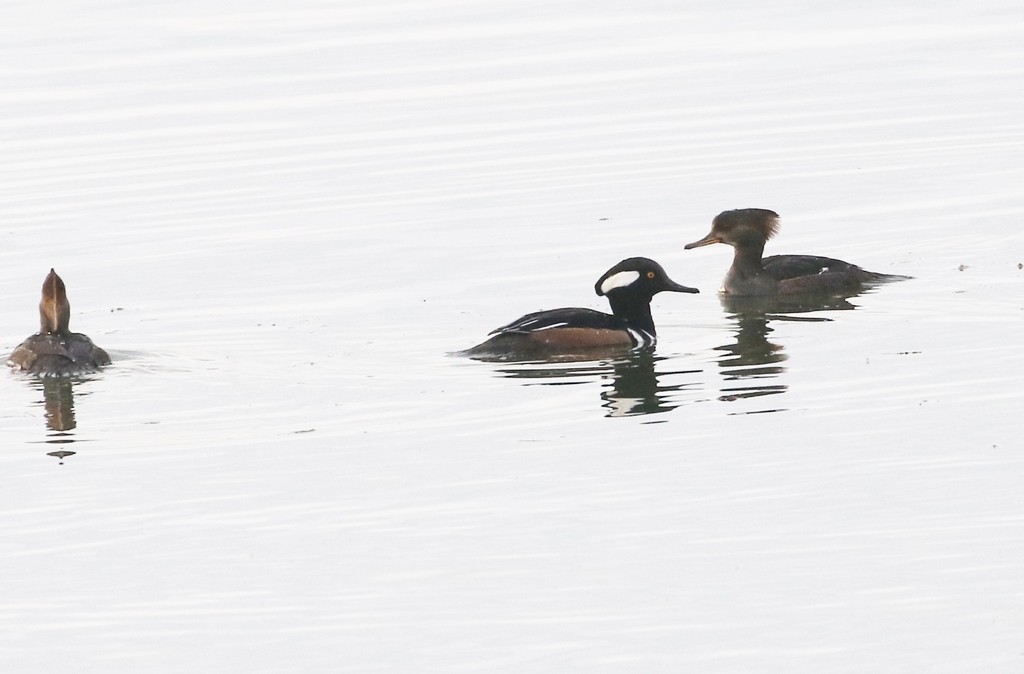Hooded Merganser
A species of Hooded Mergansers, Also known as Hooded Merganser Duck Scientific name : Lophodytes cucullatus Genus : Hooded Mergansers
Hooded Merganser, A species of Hooded Mergansers
Also known as:
Hooded Merganser Duck
Botanical name: Lophodytes cucullatus
Genus: Hooded Mergansers
Content
Description People often ask General Info
 Photo By silversea_starsong , used under CC-BY-NC-4.0 /Cropped and compressed from original
Photo By silversea_starsong , used under CC-BY-NC-4.0 /Cropped and compressed from original Description
The hooded Merganser is a small duck with a unique bill. The diving duck has a serrated bill that aids in its hunt for small fish. It typically avoids the ocean but is found in ponds and wooded swamps. It is not a social bird, preferring to stay in pairs or small flocks.
Size
41-48 cm (16-19 in)
Colors
Brown
Red
Gray
White
Life Expectancy
11.5 years
Nest Placement
Cavity
Clutch Size
5 - 13 eggs
Incubation Period
1 brood
Number of Broods
26 - 41 days
Nestling Period
1 day
Feeding Habits
Hooded Merganser primarily consumes small fish, aquatic insects, crustaceans, amphibians, vegetation, and mollusks. Diving in clear, shallow waters, hooded Merganser hunts by sight, using eyes adept at underwater vision. Hooded Merganser swims and propels with feet, grabbing prey with serrated bills. Ducklings dive from day one, improving over time.
Habitat
Hooded Merganser inhabit forested wetlands, primarily in eastern North America and the Pacific Northwest. Favoring freshwater areas, they are versatile to brackish conditions and varied woodland ecosystems. Key habitats include marshes, ponds, small lakes, and rivers with abundant aquatic vegetation. They adapt to treeless wetlands using nest boxes and rely on ice-free zones in winter, also occupying shallow bays and estuaries.
Nest Behavior
The female hooded Merganser selects the site and may reuse it, adding down after egg-laying begins. Nest building starts at the end of the breeding season, and parental care involves the female incubating the eggs.
Nest Characteristics
Nest sites for hooded Merganser are typically found in tree cavities near water, at heights of 10 to 90 feet. Females use existing materials, adding down feathers for a shallow bowl. Cavities with 3-5 inch openings are chosen, often in boxes filled with wood shavings.
Dite type
Piscivorous
People often ask
General Info
Feeding Habits
Bird food type
Bird Feeder Type

Platform
Behavior
Hooded Merganser typically exhibit low-slung swimming due to their leg placement, which also results in their awkward movement on land. Their daily activities include running across water surfaces to take flight, followed by rapid wingbeats and an absence of gliding save for when landing. Socially, hooded Merganser are found in pairs or small clusters, partaking in elaborate group courtship involving males showcasing their distinctive crests and both genders engaging in unique head-bobbing and vocal displays. Remarkably, during the nesting season males may leave their mates post-mating, with the females potentially performing a broken-wing act to shield their brood from various predators.
Distribution Area
Hooded mergansers are short-distance migrants, and they winter in the United States in regions where winter temperatures allow for ice-free conditions on ponds, lakes and rivers. They have two major year-round ranges. One is in the Eastern United States from the southern Canada–US border along the Atlantic Coast to the Gulf Coast in the region of the Mississippi delta. A smaller year-round range extends from Washington state and southern British Columbia to northern Idaho. They also breed to some extent in regions from Missouri to southern Canada and from Nova Scotia to eastern North Dakota and Saskatchewan, migrating when necessary to avoid winter conditions. For preference the hooded merganser lives on small bodies of water such as ponds and small estuaries where there is ample emergent aquatic vegetation, but it also inhabits larger wetlands, impoundments, flooded timber, and rivers. They prefer fresh water but do occur on brackish water bodies as well. 
Species Status
Population declines in the past have been linked with large scale deforestation. Because these waterfowl are cavity nesters, they require mature trees in which suitable nesting sites are likely to be found. It has been suggested that in recent years proper timber management is increasing available habitat successfully. One priority consideration when managing wooded habitat for cavity nesting ducks, is to maintain a sufficient population of mature trees in which suitable nesting cavities would be plentiful. In addition these ducks do make use of artificial nest boxes when available. Because of their high reliance on aquatic prey, hooded mergansers are very susceptible to harm from many types of pollution, some of which are poisons that accumulate in the food organisms, directly poisoning predators high in the food chain, and some of which simply reduce the populations of their prey. 
Scientific Classification
Phylum
Chordates Class
Birds Order
Waterfowl Family
Geese Genus
Hooded Mergansers Species
Hooded Merganser